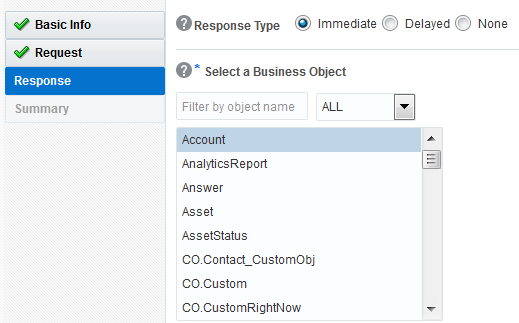Trigger Response Page
Enter the Oracle ERP Cloud operation and business object values that comprise the trigger response for your integration.
The Response page looks as follows:
Description of the illustration ics_repsonse_page.png
Select the type of response appropriate to your business requirements:
-
Immediate (synchronous) response: A response business object is immediately returned as output. You select Immediate as the response type on the Response page and select the business object as part of the response to the client. (See Immediate (Synchronous) Response is Required for instructions.)
-
Delayed (asynchronous) response: A callback service to which to route the callback is exposed. You select Delayed as the response type on the Response page and select the operation and business object that comprise a successful callback response, a failed callback response, or both. (See Table 3-2 for instructions.)
-
No response is required: You select None on the Response page because a response is not required. (See Response Type — None for instructions.)
The following table describes the fields available if an immediate (synchronous) response is required.
Table 3-1 Response Type — Immediate (Synchronous) Response is Required
| Element | Description |
|---|---|
|
Response Type |
Select Immediate for the Oracle ERP Cloud application to wait until a response is received from the integration. This is also known as the request and response message exchange pattern. This is the default selection. |
|
Filter by object name |
Enter the initial letters to filter the display of business objects. |
|
Select a Business Object |
Select the business object to receive from the Oracle ERP Cloud application as a response. A description of the selected business object is displayed below this list. |
|
Name |
Displays the name of the selected business object. |
|
Description |
Displays the description of the selected business object. |
The following table describes the fields available if a delayed (asynchronous) callback response is required. You can configure a successful callback response, a failed callback response, or both.
Table 3-2 Response Type — Delayed (Asynchronous) Response is Required
| Element | Description |
|---|---|
|
Response Type |
Select Delayed to configure a successful callback response, a failed callback response, or both. This enables you to configure the operation and business objects that you want the Oracle ERP Cloud application to process as part of a successful callback response, failed callback response, or both. |
|
Successful Response/Failed Response |
Select the type of callback to configure. After configuring one type of callback (for example, successful), you can configure the other type (for example, failed).
|
|
Select the operation to perform on the business object |
Select the operation to perform on the business object. |
|
Life Cycle |
Displays the current state of the selected business document. Active indicates the business document is available for use. Deprecated indicates the business document is nearing the end of use and must be used with caution. |
|
Name |
Displays the name of the selected business object. |
|
Description |
Displays the description of the selected business object. |
The following table describes the fields available if no response is required.
Table 3-3 Response Type — None
| Element | Description |
|---|---|
|
Response Type |
Select None. |
|
Select a Business Object |
If you select None, this section is hidden. |